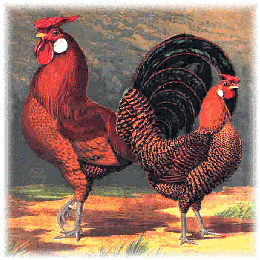
Ludlow's painting from the first edition
of Wright's Book of Poultry
(Note the coarseness of pencilling compared to the later plate)
Unfortunately, most pencilled Hamburghs seen today
are crossed between cockerel and pullet strains and therefore, have many faults difficult
to eradicate. The object of the serious breeder is to attempt to separate the two strains
by judicious breeding and try to recreate strains of exhibition birds of both sexes. This
is how I have gone about doing this in my own yard with good success.
First Year
Carefully look all your
birds over and cull out any which have undesirable traits or deformities. The idea is to
find birds which show strong traits of each strain.
The Females
Select females as close
to exhibition quality as possible. They must have sound heads and be well marked across
the breast. A common indicator of crossed strains is markings on the breast which appear
as double or triple lacing rather than pencilling. Hens having these markings can be used
in the first cross, but NEVER use any female which has a distinct break in the markings,
showing feathers with no black at all. Look for good quality pencilling on the rump and
thighs. The pencilling on the back and wings will most likely be a little mossy, this
being acceptable. Select some with darker reddish bay ground colour and some with golden
bay. Separate the females into pens which have birds of similar ground colour. Ideally,
single mate. You may find you only have one of each colour female to use.... this is
better than using birds which carry undesirable traits (I only used two females to create
both my exhibition lines).
The Male
Select an UNRELATED
male, which is primarily exhibition cockerel strain, but which still shows traits of a
pullet strain. The most common indicators of pullet strain are a lack of clear, bright
lacing in the tail furnishings, (such tails sometimes appearing a nutty brown colour
rather than black) and more pencilling in the wing and rump than would usually be found on
an exhibition cockerel. His ground colour may be a shade darker than that found in an
exhibition male, but do not select a bird that is too dark. Avoid any birds which show
white in the main wing feathers as this will increase in the offspring.
Use the one male bird exclusively in this first season.
The Offspring
The progeny of this
first year will be a mixed lot. Cull heavily for physical defects and head faults. Any
which come with white in the feather (commonly in the wing and on the hackle tips) are
discarded. You will find that you will see two distinct colour variations in these first
chickens as well as variations in markings. You will almost be able to tell which birds
are from what mating, the differences are often that profound.
Cockerels
There will be two very distinct types of cockerels,
easily distinguished by ground colour. The brighter coloured males will in all probability
show improved tail markings and less black in the body. These will form the foundation of
your cockerel strain.
The darker cockerels will have more black pencilling through the body and wings as well as
poor tail markings, though you may find a slight improvement here if you used a
nutty-brown tailed sire. Discard any which have dull brown patches in the
plumage and lighter feather tips on the breast and underside. Select those which show more
pencilling on the body and wings, though make sure the wing pencilling is as fine as
possible and even. These cockerels will be used in your pullet strain.
Pullets
Any pullets with broken fronts must be discarded.
Pullets which show clearer markings on the back and wings, with bright ground colour will
form the foundation for your pullet strain. The ones with darker ground colour and
coarser, mossy pencilling will be used in the cockerel strain. I have found often it is
quite easy to pick the daughters of a particular hen from these first matings.
You have now built the foundations for both your
strains. I must stress here, the need to cull heavily. Failure to do so now, will set you
back in subsequent generations.
This essay is written
from my own personal experiences and from hints given me by old breeders now passed on. |
Look for females with |
Rich,
golden bay ground colour
Sound markings on the breast
Even pencilling all over with some mossiness permitted on back and wings... and |
females with |
Darker
reddish bay ground colour
Sound markings on the breast
Even pencilling all over with mossiness permitted on back and wings |
Look for a male with |
Intermediate
red bay body colour with no dull brown patches
Some pencilling on his wings and body
Full black tail with some lacing (it may be a nutty brown tail)
Unrelated to the females |
|